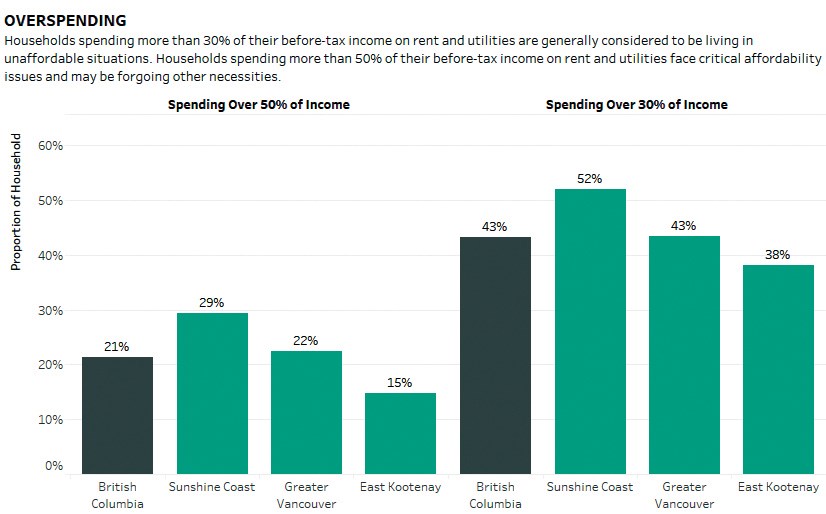In a province with the highest share of households in Canada overspending on rent, the Sunshine Coast Regional District (SCRD) and District of Sechelt are faring among the worst.
Twenty-nine per cent of renters in the SCRD and the District of Sechelt are spending more than half their income on rent and utilities. The rate in Gibsons is 25 per cent. The provincial average is 21 per cent and the national average is 18 per cent. Both municipalities are included in the SCRD data.
Among municipalities, Sechelt ranks third highest in Canada for residents who spend more than 50 per cent of their gross income on rent, tied with Vaughn and Markham, Ont. Ahead of it are Richmond Hill, Ont. (32 per cent) and West Vancouver (37 per cent).
Jill Atkey, CEO of the B.C. Non-Profit Housing Association, called the situation on the Sunshine Coast “severe.”
The findings come out of the 2018 Canadian Rental Housing Index, released May 8 by the association in partnership with local organizations across Canada. The statistics are based on a customized 2016 census data set of 800 jurisdictions in Canada.
According to the authors of the Index, “B.C. has the most renter households in the country (21.3 per cent) spending more than half of their gross income on rent and utilities. This is considered a crisis level of spending, putting individuals and families at risk of homelessness. This problem is the worst in the Sunshine Coast Regional District.”
The study also found that unaffordable rent is as much a rural problem as an urban one. The index highlights the Sunshine Coast, Metro Vancouver and the East Kootenay Regional District as the most challenged areas.
“What we thought for a long time is a big city problem seems to have shifted. This really isn’t an urban problem and is really reaching every corner of the country and in our case, the province. What was particularly startling was Sechelt,” Atkey said.
In Sechelt, more than half of renters spend over 30 per cent of household income on rent and utilities, which is considered the threshold for affordability. Gibsons isn’t far behind, with just under 50 per cent overspending on rental housing.
Atkey said supply and lower median income are likely to blame. “Purpose-built rental housing hasn’t really been built anywhere in the province in the past 25 years. So they are probably relying more on the secondary rental market, so basement suites and home rentals, which is less secure,” Atkey said.
It’s a perception shared by Matt Thomson, community housing lead for Urban Matters, based on the Sunshine Coast. He said a “significant outflow” of Vancouver residents are moving to the Coast, which is adding pressure to a market that already has a dearth of purpose-built rental housing.
He also noted that many of the secondary dwellings that were once intended for long-term renters are now being used as vacation rentals, which many homeowners rely on to pay their mortgages.
“One thing we’ve heard a lot of anecdotally is that when open houses are showing … there can be anywhere from 40 to 50 people show up,” said Thomson. “We’re getting the pressure of a big city but we don’t have the rental to absorb.”
Supply may be down, but rental households are on the rise across B.C. They have climbed 14 per cent in the past five years to 600,000. The Index also found that across Canada, the increase in household income is being outpaced by the rising cost of rental housing.
Sunshine Coast Regional Economic Development Organization (SCREDO) recently launched a campaign encouraging homeowners to add secondary dwellings, or Victory Suites, to deal with the shortage.
The three provinces with the highest rent are Alberta ($1,279), Northwest Territories ($1,191) and B.C. ($1,148).



